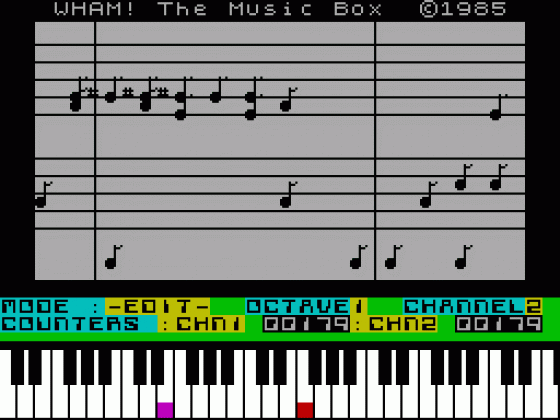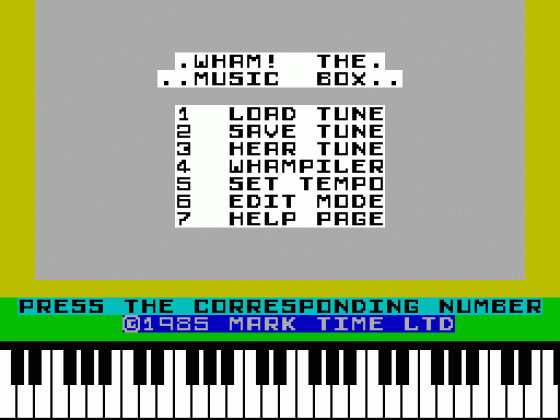
Your Sinclair
 1st March 1986
1st March 1986
Author: Iolo Davidson
Publisher: Melbourne House
Machine: Spectrum 48K
Published in Your Sinclair #3
Wham! The Music Box
By George, an 'Andy marketing release, you're thinking to link rock wonders Wham! with the Music Box software. Iolo Davidson goes Wham! Bam! Thank you Melbourne Hourse and makes a few notes of his own.
This program comes with five of the faberoony Wham! mega-smashes stored in the Music Box's tune memory. Don't ask me what their squillions of fans would make of a Speccy cover version of Young Guns, though!
If you ever tire of the Dynamic Duo's ditties you can erase them and compose your own, or key in tunes from sheet music. This is what the program's really about so serious musicians or Duranees need not be put off by the Wham! label.

Besides the music editor, with its easy method of on-screen composition, this program gives your Spectrum an extra sound channel. That means you can play two different notes simultaneously, for two part harmony or simple chords. You'll want some method of amplification t get the most from this program, as no software can cure the innately feeble Speccy beeper.
Once you've composed your hit (or pinched someone else's) you can save it to tape or microdrive, complete with the machine code routine that plays it, as a block of code for inclusion in you own programs. No mention is made of the copyright situation on the inlay, though, so I've no idea what'd happen if you wanted to use this music in a program for commercial resale.
Terry Bulfib's had a quick hack and informs us that there is 4K of Basic inside, and more importantly, that the loading and saving of tunes is done in Basic. This means that the microdrive Save and Load options will also work on other drives that use microdrive syntax, like the Opus disk or Wafadrives.
What makes it all a doddle to use, and cancels all my previous quibbles us the easy editing. You can play in notes by ear, seeing each key you've pressed marked on both the screen's piano keyboard and the stave. You'll hear it as well and by backspacing you can remove mistakes. You can go through the score note by note, or fast forward through it. Otherwise, just play the tune, all the time with a continual display on the piano keyboard and staves. Plus you can listen to the sound of the notes.
Besides the organ like twin voices, you get a 'bass drum' and three somewhat programmable sound effects based on white noise. You can also alter the playing speed. What you can't do is obtain a printout of the musical score - but since the notation is weird, you won't want to.
First they gave programmers the pop star treatment, now the customers get to be pop stars. I hope all this music doesn't lead you to throw your TV out the hotel window.



